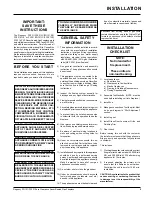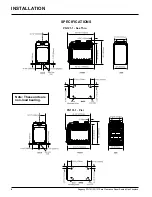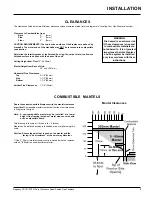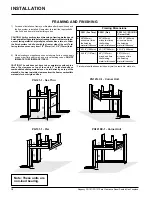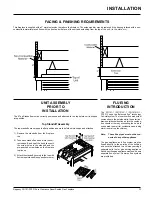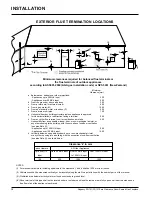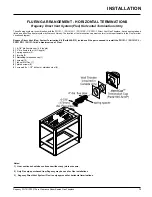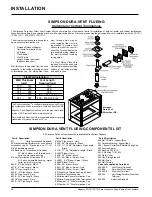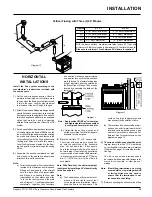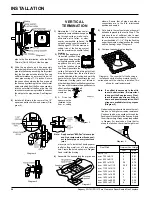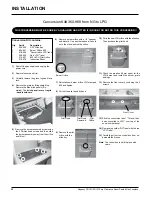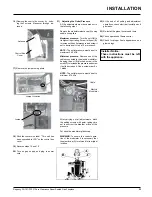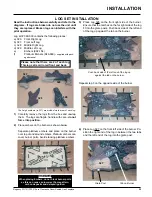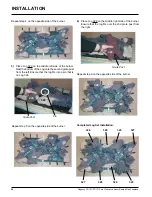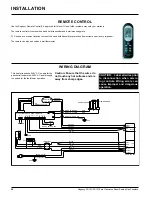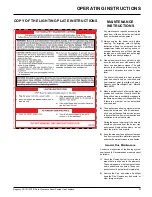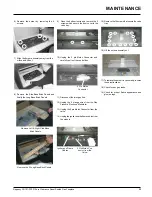
Regency PG121/PG131 Zero Clearance Room Sealed Gas Fireplace
19
INSTALLATION
HORIZONTAL
INSTALLATIONS
Install the flue system according to the
manufacturer's instructions included with
the components.
1)
Set the unit in its desired location. Check to
determine if wall studs or roof rafters are in
the way when the flueing system is attached.
If this is the case, you may want to adjust
the location of the unit. Rough in the gas.
2)
Direct Flue pipe and fittings are designed with
special twist-lock connections to connect the
flueing system to the appliance flue outlet. A
twist-lock appliance adaptor is an available
option that must be used in conjunction
with the Simpson Dura-Vent Direct Vent GS
system.
3)
Put a bead of silicone inside the outer section
of the adapter and a bead of Mill Pac on the
inner collar. Slip the adapter over the existing
inner and outer flue collar and fasten to the
outer collar only with the 3 supplied screws
(drilling pilot holes will make this easier).
Level the fireplace and fasten it to the fram
-
ing using nails or screws through the nailing
strips.
4)
Assemble the desired combination of pipe
and elbows to the appliance adaptor and
twist-lock for a solid connection.
Note:
a) Twist-lock procedure: Four indentations,
located on the female ends of pipes and
fittings, are designed to slide straight
onto the male ends of adjacent pipes
and fittings, by orienting the four pipe
indentations so they match and slide
in to the four entry slots on the male
ends, Diagram 1. Push the pipe sections
completely together, then twist-lock
Diagram 1
ported every three feet. Wall straps are
available for this purpose.
5)
Mark the wall for a 10" x 10" square hole.
The center of the square hole should line
up with the centerline of the horizontal
pipe. Cut and frame the 10 inch square
hole in the exterior wall where the flue will
be terminated. If the wall being penetrated
is constructed of non-combustible material,
i.e. masonry block or concrete, a 7"(178mm)
dia. (7-1/2"(191mm) dia. for flex) hole is
acceptable.
Note: With Dura-Vent, the minimum height
is achieved by installing a 45
o
elbow directly
to the flue adaptor.
Note:
a)
The horizontal run of flue must be level,
or have a 1/4 inch rise for every 1 foot
of run towards the termination. Never
allow the flue to run downward. This
Diagram 2
could cause high temperatures and
may present the possibility of a fire.
b)
The location of the horizontal flue termi
-
nation on an exterior wall must meet all
local and national building codes, and
must not be blocked or obstructed. For
External Flue Terminal Locations, see
diagram on page 12.
6)
The arrow on the flue cap should be point
-
ing up.
Insure that the 1-1/2" clearances
to combustible materials are maintained
(Diagram 3 on page 16). Install the termina
-
tion cap.
The four wood screws provided should
be replaced with appropriate fasteners for
stucco, brick, concrete, or other types of
sidings.
Note: If installing termination on a siding
covered wall, a vinyl siding standoff
or furring strips must be used to
ensure that the termination is not
recessed into the siding.
7)
Before connecting the horizontal run of flue
Note: Apply sealant "Mill-Pac" to inner pipe
and high temperature silicone sealant
to outer pipe on every twist-lock joint.
b)
Horizontal runs of flue must be sup
-
Diagram 12
Vertical Flueing with Three (3) 90
o
Elbows
Option
V + V1
H + H1
A)
2' (610mm) Minimum
3' (914mm) Maximum
B) 3' (914mm) Minimum
6' (1.86m) Maximum
C) 4' (1.22m) Minimum
9' (2.7m) Maximum
D) 5' (1.5m) Minimum
12' (3.6m) Maximum
one section clockwise approximately
one-quarter turn, until the two sections
are fully locked. The female locking lugs
will not be visible from the outside, on
the Black Pipe or fittings. They may be
located by examining the inside of the
female ends.
With the above options, maximum total pipe length if 37 feet with
minimum of 5 feet total vertical and maximum 12 feet total horizontal.
Please note minimum 1 foot between 90
o
elbows is required.

